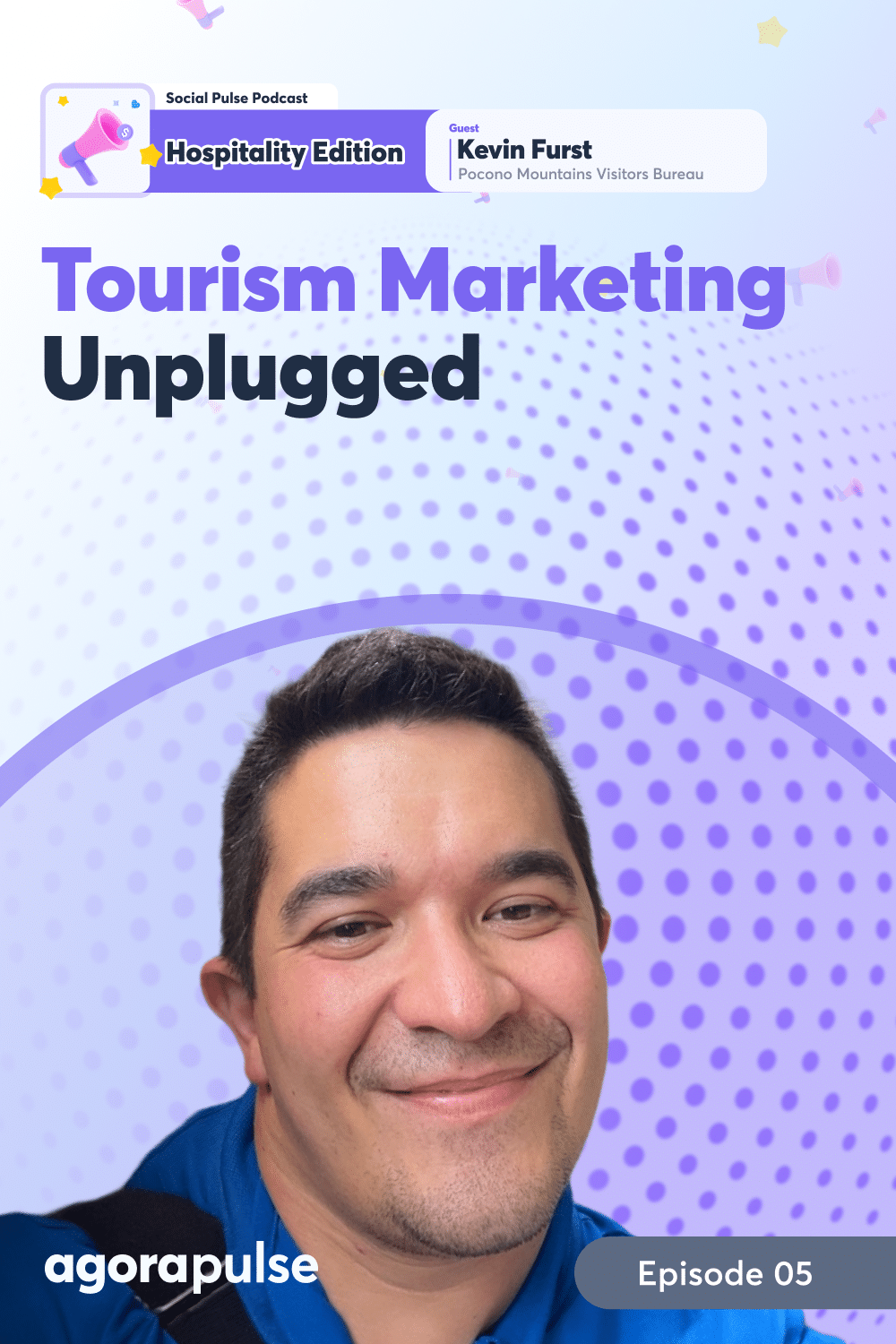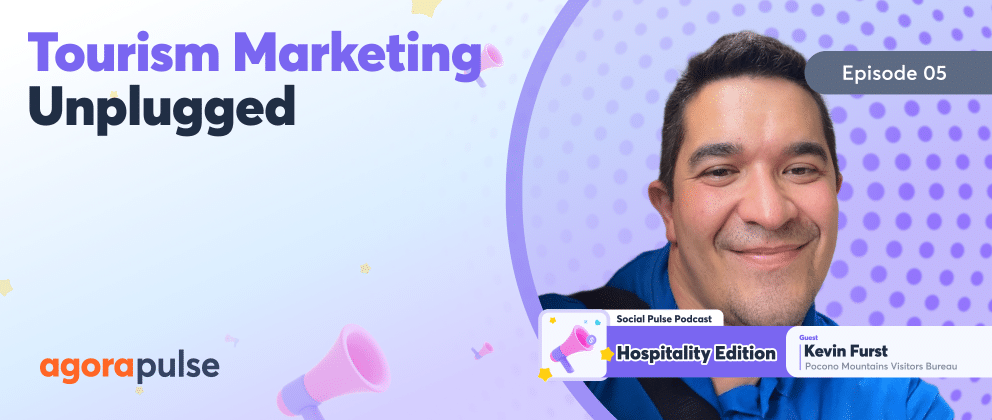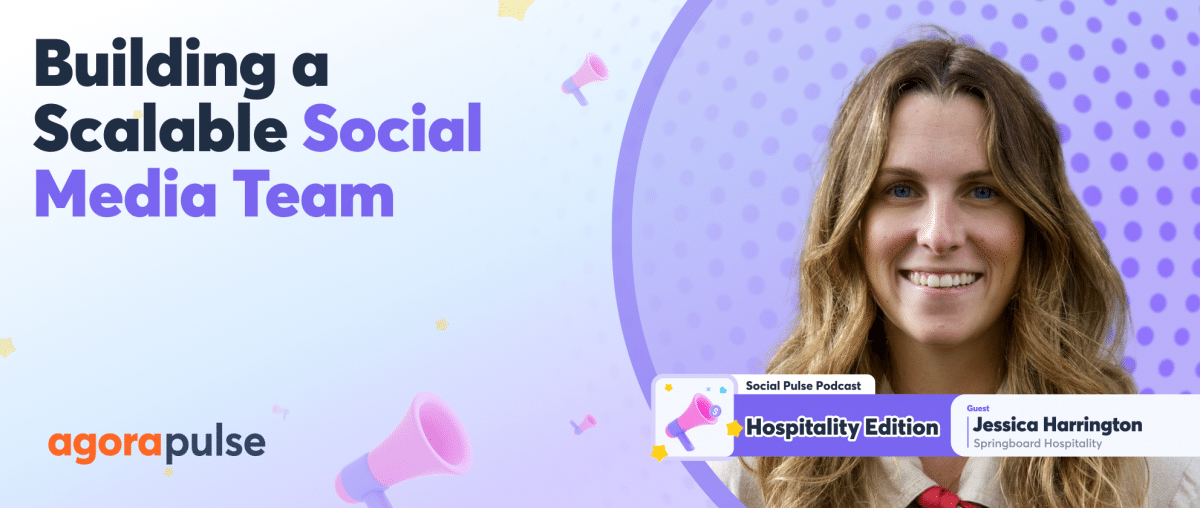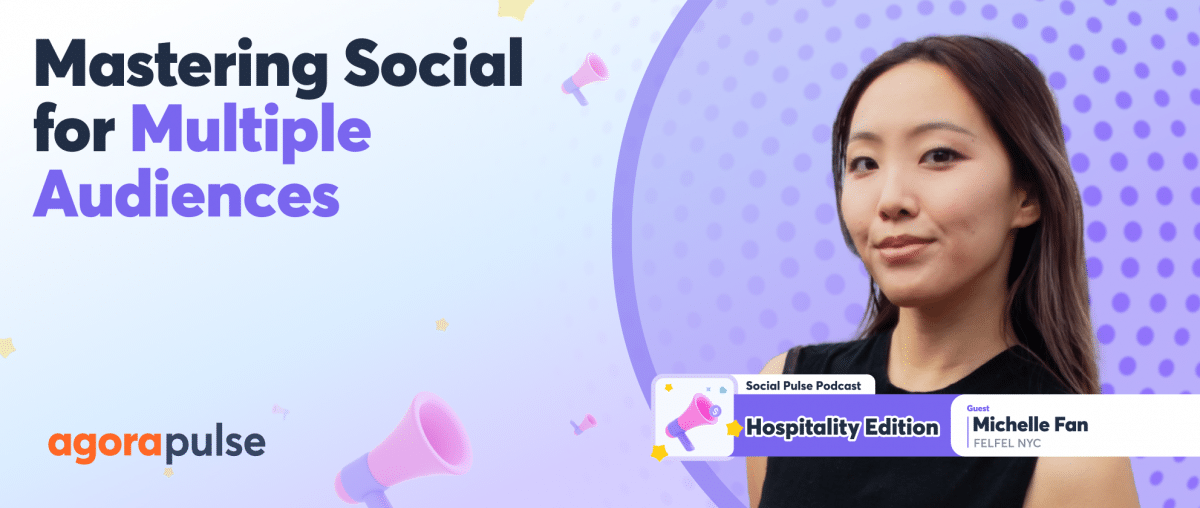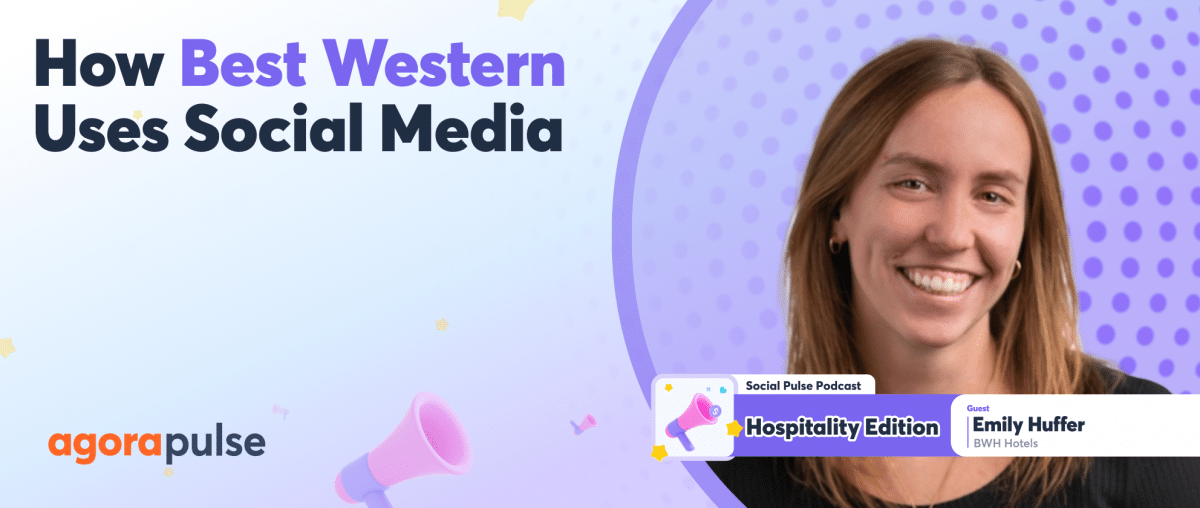Social media marketing for tourism is no walk in the park. Constantly battling to stay relevant and engaging in the fast-paced digital landscape can feel like an uphill climb, the unique blend of promoting destinations, driving sales, and keeping an audience captivated is riddled with challenges.
How do you break through the noise?
How do you maintain engagement and drive results in an ever-changing industry?
The frustration and pressure can be overwhelming—but the good news is there are proven strategies and solutions to these hurdles.
Our guest today is the key to unlocking these solutions. Kevin Furst, the social media manager at Pocono Mountains Visitors Bureau, has an impressive background in crafting successful social media campaigns and building engaging communities with experiences spanning from consumer packaged goods to the ski and recreation industry. Kevin has consistently turned challenges into triumphs through creative and innovative solutions.
Today, Kevin will share his insights and experiences on navigating the social media challenges in the tourism sector.
[Listen to the full episode of the Social Pulse: Hospitality Edition (powered by Agorapulse) below or read on for the transcript highlights.]
And you can sign up now for a free trial of Agorapulse and get started right away.
Common Tourism Marketing Challenges
Can you start by sharing some of the common challenges you face in social media marketing for tourism?
Kevin Furst: For the Pocono Mountain Visitors Bureau, what makes us so unique is how large we are as a destination. We’re about 2,400 square miles, which is roughly the size of the state of Delaware. We are also a membership-based organization. So we have 600+ members who are essentially our clients, and we are posting on their behalf to our audience of almost 675,000 followers across all platforms. So one of the major challenges we have is making sure that we get enough content for our members and making sure that they’re getting posted on these platforms. As you can imagine with 600+ members and a social media team with two people, getting to all those members and creating all that content for the members can be quite a challenge.
We like to break everything down by season. We are a four-season destination, so we have a lot of members and businesses that are just winter-based. We have some that are just solely summer, so we’re always thinking two to three months ahead just so we can get that content—whether it’s us going out and capturing it, whether it’s us requesting that content from the member. We’re always two to three months ahead just to make sure that we have all of our content lined up. Do we have to go out and get a video for a Reel, for a TikTok? Do we have to help get some photos for an upcoming blog post?
I think one of the biggest challenges for us in the Pocono Mountains is covering such a large area with 600+ members. But we’ve come up with some creative solutions to help us make sure we’re checking all those boxes and getting our members out in the social mix.
Mike Allton: That is, first of all, a huge knowledge bomb that you’ve dropped already, which is that we need to be thinking seasonally, folks. We need to be thinking ahead and planning for the kind of content and conversations that we’re going to want to have two, three, four months down the road.
Just to help me understand real quick: The businesses, the resorts, and that sort of thing in the Poconos—are they members of your organization?
Kevin Furst: Yes. So we cover a four-county region in the Poconos, and everybody from a large waterpark resort right down to a mom-and-pop shop boutique can sign on to become members and get some pretty major benefits at becoming a member through social media coverage. We have our television network, Pocono Television Network, and blogs, our website, and billboards. So we have a lot of resources available to these members for most of the time, a very small fee. We help them get their business out in front of millions of people.
Staying Ahead With Audience Engagement
Mike Allton: You’re covering a massive landmass. You also are working and serving a huge number of local businesses all while trying to stay ahead of an industry that’s changing quite rapidly all the time. How do you do that?
How are you staying ahead? How are you maintaining audience engagement on social media?
Kevin Furst: The biggest thing we do to stay ahead is, when I first started the job three years ago, I came in and [about] three months in, they’re like, “So what did we do for member XYZ?” And I just sat there at my desk, like, “I can’t tell you, I have no idea.”
So I built this massive spreadsheet that tracked how many times we posted, what time of the day, and this was the time I was doing everything manually. So I could quickly look at this spreadsheet and see how many posts per season, and how many posts per quarter each one of those members got. And that helped get me to a certain point.
Asana
But then we implemented Asana. So with Asana, our entire PR and marketing teams can go on there and see what content, what themes—whether it’s an annual event coming up or a social media holiday, or upcoming blogs.
- We do a lot of posts that are centered around our blogs, more itinerary-based. So that helps plan out some of that content in advance.
- We’re also looking backward, too. So at the beginning of each month, we’ll look at the previous three months to see what content performed the best. And then since we’re planning two to three months, we’ll look at the content that we posted that month for the last three years, so that’ll help us identify any annual events that maybe a member didn’t send to us yet or any events that we don’t have updated date and time for any social media holidays. You know that there’s a social media holiday for just about everything. We always look to see if there are any that we missed that did well in the previous three years.
- We’re using the spreadsheet just to check out how many posts each member had in Asana for our entire team to collaborate, across marketing membership, PR, and the television network. So we’re using all of that to help create content, and then we’re also using our website search data. I’ll go in there weekly and see what visitors to our website are searching for.
- A good example was last February. Every year for Valentine’s Day, we’ll go in, I would say, like the last week of January, early February, [is when] we’ll start posting Valentine’s Day content. Last year, when I went in early January, Valentine’s Day was already the third most searched topic on the website, so we pivoted pretty quickly and started posting that Valentine’s Day content knowing that’s what people were looking for.
- We were always looking at all the different data sources and also what the visitors were commenting on each of the channels. We’ll look at all that and then, monthly, we’ll also post just a text post on Facebook, saying, “What are you looking forward to the most this fall in the Poconos?” We’ll categorize each one of those comments on that post to help us cater to what upcoming content we should start producing.
How have you worked with specific campaigns?
(An example may be of a challenging campaign and how you navigated it successfully.)
Kevin Furst: Last year, we had a pretty mild winter, and we struggled with getting our visitors to know that our ski areas are open.
If someone’s coming from New York City or Philadelphia, and it’s 50 degrees, and there’s no snow in the backyard, people are not necessarily thinking about skiing. So last year we launched a campaign to promote all our live webcams throughout the region. We have one or multiple live webcams at each one of the ski areas. We were posting weekly a live look-in at this specific ski area with everything that ski area has to offer.
Whether it was “kick off the ski season,” or “this ski area is making snow,” or “January’s Learn to Ski Snowboard Month,” we were identifying certain key events and activities at each one of the resorts and using our live webcams as a way to show people, “Hey, it’s cold here. It may not be snowing, and it may not be 32 degrees in New York City, but we’ve got tons of snow. Come out for the day, come out for a weekend.” So we used that both on social media. We put that on billboards throughout the region as well, as digital campaigns, and also ran some broadcast commercials around our live webcams—and it was an easy way to use tools we already had with the live webcams to get the word out.
Mike Allton: But that’s also a complete omnichannel campaign. So that is impressive. A lot of marketers haven’t tackled that specifically. You mentioned two social media pros on your team. How big is the team overall?
Kevin Furst: It’s myself and the social media coordinator. For social media, the entire marketing team. I think there’s eight of us now.
Mike Allton: Still not a large team and yet you’re doing these boots-on-the-ground campaigns that are coordinated with digital campaigns. That’s terrific.
View this post on Instagram
Community Engagement
Let’s talk about community engagement—because a lot of the folks that I’ve talked to on this show [know] that community is huge, and some would argue it’s essential. I’m wondering how and what the role of community engagement is, and how that plays off into your overall social media strategy.
Kevin Furst: Community engagement is probably one of the biggest things that we look at for the success of a social media post.
“It’s nice to have 10,000 followers, but we don’t really look at any of the vanity metrics in terms of follower count. We look at the amount of likes, comments, and shares on a post to see how successful each one is. And then, like I said earlier, we’ll go back the month before just to see which one of those posts had the most engagement and see what we can do to replicate that type of content for that upcoming month of content.” (Kevin Furst, Pocono Mountain Visitors Bureau)
We do have a team that helps with answering our comments, so we do try to go in and answer every social media comment posted on all of our channels within two hours, and we do it in such a way that will elicit a response.
So, we’re asking if someone says, “I had such a great time there,” and say they went whitewater rafting, we’ll ask them, “Was it your first time? Did you stay for the bonfire after?” We’ll ask them some questions that hopefully get a response back just to start that conversation.
We’ve also had posts go out and campaigns where somebody will ask a question, and then we turn around and plan their entire vacation to the Pocono Mountains just through the comments and DMs, which is pretty cool.
So they’ll say, “Hey, I’m coming to Stroudsburg, we’re staying here, and it’s just me and my wife. What can we do?” So, we’ll hook them up with the Historic Walking Tour, the Pocono Beverage Trail. If they like outdoor hiking, we’ll direct them to different hiking trails within the Delaware Water Gap. We’ll build that entire itinerary, and on our website, we do have an itinerary builder. We can build the whole thing out, send them the link, and all they have to do is click on it, and they have their entire trip ready to go.
We always try our best to answer the questions and be as transparent as we can in answering if somebody has a question about anything to keep that engagement going.
Mike Allton: You already talked once about how you were integrating social media, the live feeds at the billboards, and that sort of thing.
Do you have any other examples of how you integrate your social media efforts with some of those other omni-channel mediums?
Kevin Furst: One we launched recently is another focus on our small towns.
We are going out and capturing social media content that is itinerary-based.
So say it’s, “Hey, check out five places to eat in downtown Stroudsburg. If you love the outdoors, make sure you check out Delaware Water Gap,” and we’ll build out an itinerary from the hike to a place to eat or a different place to shop for, let’s say, a TikTok or a Reel.
Then we have billboards on the major interstates that say, “Check out Delaware Water Gap exit 310” that are on the highway leading up to that exit off the highway before they go into New Jersey.
And then with our broadcast commercial, we have—I think at this point—something pretty much for all of our large, major small towns in the Poconos showing off everything they have to offer.
A lot of this wouldn’t be possible without [our] quarterly, strategic content meetings with the entire team and leadership and our membership team. Whether someone on our board mentions certain things they’re seeing within their communities, or if they’re seeing certain things slow down in their neighborhood, or at their business, we’ll work that into our content.
And then we also listen to all of our members, so we send out quarterly emails with a survey of, “What are you guys doing? What can we do better? How can we help?” And we use that to plan all of our campaigns.
View this post on Instagram
What are some creative solutions that you’ve implemented to overcome obstacles and drive results?
Kevin Furst: Not a sponsored podcast here, but we recently this year just started using Agorapulse, and that was a huge tool that we brought into our marketing mix and social media mix as well. That has so far saved us so much time in scheduling content, as well as listening to what our followers and visitors are saying and what our members are saying on the platforms as well.
But also a big part of it was [that] we were missing the major component of reporting, and then reporting was a big thing that we were missing. So we would have members reach out—whether it’s monthly, or after a large event. If we’re doing a co-op, they would reach out asking how everything performed, on social media.
And before that was all manual. So we were going into each backend of the platforms, finding the date that those were posted for that specific member or event, pulling all that data, putting it into a spreadsheet, and making pretty graphs and charts, which would take hours.
So now with the Agorapulse platform and using the labels, we’re able to pull a report and get it off to a member in five or ten minutes. And because each one of these members is a stakeholder, we do label each one of our posts with the county that it’s in, the city it’s in, the name of the business or member, any key attributes, whether it’s outdoor adventure, biking, or winter campaign, or if it’s a blog post or if it’s on our television network.
We can quickly create those reports and see how something’s performing, and then I also see how we can improve things as well for upcoming campaigns or posts.
Mike Allton: Okay, I also have to be transparent: I didn’t know that … that Kevin used Agorapulse. I wasn’t aware you were a customer. So thank you for sharing that. That’s fantastic!
I love that you’re using the labels as you were talking about your use. As soon as you mentioned having to find manually a post that one of your members was interested in, the labels feature popped into my mind.
And for those who aren’t familiar, if you’re not using Agorapulse, anytime you share a post, or even if you’re looking at a comment or a direct message, you can label it inside of Agorapulse. That just makes it super easy to surface that kind of content in a variety of ways. And the labels are up to you.
So you can use it just like Kevin said for counties or specific members, you could use it for types of posts. There’s a lot of options there. So back to you guys, Kevin, I want to talk more about the work that you’re doing because it sounds like you’re doing a lot of education.
How important do you think educating your audience about the benefits of all these different destinations you’re promoting is?
Kevin Furst: Education is super important for not only the visitor but also our members. So we do a little bit of both.
We have quarterly meetings with our members to let them know what’s available and how we can help with social media as one of those tools. And then we also educate them on what we’re seeing in certain trends, what’s performing well, and what content we need from them—whether they post it themselves and we repurpose it, or we come out and capture that content of what our audience wants and what they’re looking for.
On the visitor side, it’s been a lot of trial and error as social media platforms are changing what seems like daily.
We’ve learned through our audience, looking at TikTok, our itineraries, showing a tour, and day-in-the-life-of content performs well. Visitors are using social media now more than search engines to plan their trips. The more we can pack into that 30-45 second video, showing them, “Hey, 9:00 am, I’m grabbing breakfast here, at 10:30 am I’m hitting the trails here. 1 pm. I’m grabbing a beer at this brewery.” We’re planning their entire day in one post, whether it’s showing off the entire Poconos in that post or that specific town. Our content is trying to educate everybody on where or how to plan their trip but also how much there is to do here in the Poconos.
Some people just think of us as a water park destination. We have three water parks in the Poconos within 30 minutes of each other and then the six ski areas. So we’re always trying to plan that entire day. So we’ll say, “Hit the water park in the morning, and then drive 10 minutes down the road to go to the outlets to go another 10 minutes and hike in the National Park.”
That’s the type of content that resonates the most with our visitors and viewers on our platforms. Most of our platforms (except YouTube) skew heavily towards women between the ages of 25 and 45. So we cater towards that audience just because most of the time it’s the moms that are pushing that “BUY” button on the vacation. (For YouTube, which houses more long-form content for our television network, we have started jumping into YouTube Shorts.)
Mike Allton: I love that you’re focusing on telling stories and showing people what it would be like if they were there. It gives them that ability to relate and understand and see themselves as somebody who’s already enjoying a day in the Poconos, getting up early, going for a hike, and having a beer later. That’s all very storytelling-esque. So I love that.
From a tool perspective, you mentioned a couple: Asana and Agorapulse.
Are there other tools or the other features of those tools that have helped you manage and navigate social media and all the challenges they’re in?
Kevin Furst: I think just implementing both Asana and Agorapulse. Both saved us hours on a daily and weekly basis.
Asana has become a pretty big tool as well because we’ve built custom forms for our members. We’ll send out member communications where they can go into that form, let us know upcoming events/deals, and send us photos through the form. We’ll also tell them about what upcoming social media holidays are coming up in the next two to three months. And what do they offer that could tie into those holidays? And then that’ll help us with TEMA 2, get out there, and schedule time, get content for those specific days.
Related post: How to Engage With Travel Bloggers on Hospitality Social Media
I would say between Agorapulse and Asana and listening to all the podcasts out there and checking out other destinations to see what’s performing well for them.
I would say those are the biggest two that help streamline this major beast of content creation.
How do you measure it all? How are you connecting the dots between the work that you’re doing on social media and the impact that that’s having on the actual business?
Mike Allton: Are there specific metrics or KPIs that you prioritize? And like, literally, how do you connect those dots?
Kevin Furst: For us, we do look at the overall impressions and reach. But we also look at the engagement and click-throughs to our website.
For our website, we don’t want visitors spending hours on it. We want that to be a springboard to where they’ll go in, check out that member’s listing, and then hopefully hit that book now, or visit a website. So we’re tracking that entire journey from social media. Or a paid ad over. Are they clicking through to that website? We’ve changed our website and redesigned it recently, and we’re excited when we see them go to a listing, and then they’re leaving the site almost immediately to go to our member site.
Any other website might get a little scared when that bounce rate skyrockets, but we’re measuring that click-through to a member site, and we’re also getting monthly reports from Tourism Economics looking at the occupancy and overall booking and traffic into the Poconos.
We use those as the main indicators of how well the region is doing, and we’re in constant communication with each one of our members, as well as our board, which is made up of member properties. So we have a good idea of what’s performing well, where there are some weak points, and what we need to push.
Like right now we’re leading up into a very busy fall season, and our small towns do get double, triple, and quadruple the traffic for fall foliage. So we’re in the process of launching some campaigns that focus on those small towns with some tips on where to find parking, where to find the best scenic overlooks, arriving early, and itineraries.
We’re trying to get ahead of the traffic in these small towns and try to help them manage that a little better.
Mike Allton: Love those perspectives. And I couldn’t agree more with how you are measuring success. Too often, frankly, I ask people those questions, and they start talking about vanity metrics. They start talking about engagement. And that’s where they stop. I mean, it’s important. You made this point earlier to look at how much engagement you’re getting on social media, but that’s not a business metric. That’s not helping your bottom line.
If it’s not leading to traffic and actual revenue, that focus on your members is very commendable.
Kevin, this has been so much fun. I’ve loved this conversation. Folks, we’ll have all the links to Kevin and the Poconos in the show notes.
[Check out previous episode transcripts of the Social Pulse: Hospitality Edition on the Agorapulse blog.]
That’s all we’ve got for today, but don’t forget to find the Social Pulse Podcast: Hospitality Edition on Apple where we’re digging into the challenges, successes, and stories of social media community professionals in the industry, just like you. Subscribe to gain valuable insights that you’ll be able to apply to your work and social presence from every episode. Drop us a review. We’d love to know what you think.
